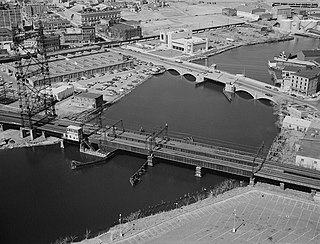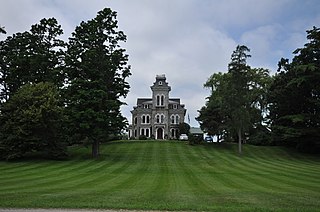
Streetcars in Washington, D.C. transported people across the city and region from 1862 until 1962.

Pittsburgh Railways was one of the predecessors of Pittsburgh Regional Transit. It had 666 PCC cars, the third largest fleet in North America. It had 68 streetcar routes, of which only three are used by the Port Authority as light rail routes. With the Port Authority's Transit Development Plan, many route names will be changed to its original, such as the 41D Brookline becoming the 39 Brookline. Many of the streetcar routes have been remembered in the route names of many Port Authority buses.

The First Methodist Church of Burlington is a historic church located at 21 Buell Street in Burlington, Vermont. Built in 1869 to a design by Alexander R. Esty, it is the city's only example of ecclesiastical Romanesque Revival architecture. It was listed on the National Register of Historic Places in 1978.

The Connecticut Railway and Lighting Company Car Barn was historic streetcar maintenance facility in Bridgeport, Connecticut. Built in 1910 and enlarged in 1920, it served as a maintenance barn first for electric streetcars and then buses for many years, and was one of the few surviving reminders of the city's early public transit system. The building was listed on the National Register of Historic Places on December 3, 1987. It was demolished in 2008 to make way for construction of the Connecticut Superior Court juvenile facility that now stands on its site.

The former Yonkers Trolley Barn is located on Main Street in Yonkers, New York, United States. It is a massive steel frame brick building in the Renaissance Revival style built at the beginning of the 20th century. In 2002 it was listed on the National Register of Historic Places as the last remaining trolley barn in Westchester County and the only remnant of Yonkers' trolley system.

The Winooski Falls Mill District is located along the Winooski River in the cities of Winooski and Burlington, Vermont, in the United States of America. It encompasses a major industrial area that developed around two sets of falls on the river in the 19th century.

Shard Villa is a historic house at Shard Villa and Columbus Smith Roads in Salisbury, Vermont, USA. Built in 1872, it is an elaborate and sophisticated example of Second Empire architecture, built by Columbus Smith, a prominent international lawyer. It was listed on the National Register of Historic Places in 1989. The property has been used for many years as an elderly care facility and is one of the oldest such facilities in continuous operation in the state.

The Downtown Essex Junction Commercial Historic District encompasses the historically railroad-dominated portion of downtown Essex Junction, Vermont. Aligned along the south side of Railroad Avenue and adjacent portions of Main Street, the area underwent most of its development between 1900 and 1940, when Essex Junction served as a major regional railroad hub. The district was listed on the National Register of Historic Places in 2004.
The Dumas Tenements are a pair of four-unit apartment buildings, set back-to-back at 114 West Allen and 114 West Canal Streets in Winooski, Vermont. Built about 1907 by a French Canadian immigrant, they are among the only buildings of their type to survive the city's urban redevelopment efforts of the late 20th century. They were listed on the National Register of Historic Places in 2012.

The Ethan Allen Engine Company No. 4 is a historic former fire and police station at 135 Church Street in Burlington, Vermont. Built in 1887 for a private fire company, it is a fine local example of 19th-century commercial architecture. It served the city as a fire and police station until the 1960s, and is now used as a commercial space. It was listed on the National Register of Historic Places in 1971, and is a contributing property to the City Hall Park Historic District.
The LeClair Avenue Historic District encompasses a small residential development on LeClair Avenue and North Street in Winooski, Vermont. Subdivided and developed by Francis LeClair, a prominent local businessman, the well-preserved working-class residences typify development of the period catering to the area's growing French-Canadian immigrant community. The district was listed on the National Register of Historic Places in 1992.

The North Street Historic District encompasses the traditional commercial area serving the residential Old North End neighborhood of Burlington, Vermont. It extends for ten blocks along North Street between North Avenue and North Winooski Avenue, and has served as the neighborhood's commercial center for over 150 years. It was listed on the National Register of Historic Places in 2001.

The Joshua Twing Gristmill is a historic industrial facility at 450 North Main Street in the city of Barre, Vermont. Built in 1844, it is a remarkably high-style example of Greek Revival architecture for an essentially utilitarian industrial structure. Joshua Twing, its builder, was engaged for many years in a variety of industrial pursuits, primarily considered with engineering improvements in water wheels and turbines. The building was listed on the National Register of Historic Places in 1978.

The Porter Screen Company is a historic former industrial facility at 110 East Spring Street in Winooski, Vermont. Developed beginning 1910–11, this mill complex was an important secondary industrial employer in the city, shipping window screens and other housing parts nationwide. The facility, now converted to senior housing, was listed on the National Register of Historic Places in 1979.

The Saltus Grocery Store is a historic mixed-use commercial and residential building at 299-301 North Winooski Street in Burlington, Vermont. Built in 1897, it is a well-preserved example of a neighborhood store of the period. It was listed on the National Register of Historic Places in 2001.

The M.S. Whitcomb Farm is a historic farm property on United States Route 2 in Richmond, Vermont. Established in the 1850s as a horse farm, it has seen agricultural use in some form since then. Its most distinguishing feature is a large bank barn with a monitor roof, built in 1901. The property, now 170 acres (69 ha), was listed on the National Register of Historic Places in 1993.

The Winooski Block is a historic commercial building at 1 through 17 East Allen Street in downtown Winooski, Vermont. Built in 1867, it is the only major building to survive the city's urban renewal activities of the 1970s, and is a fine example of post-Civil War commercial architecture. It was listed on the National Register of Historic Places in 1974.

The Wethersfield Avenue Car Barn, also known locally just as the Trolley Barn, is a historic trolley barn at 331 Wethersfield Avenue in Hartford, Connecticut. Built in 1902, it is the only surviving building used exclusively for the area's extensive electrified street car network in the first half of the 20th century. Now converted to other uses, it was listed on National Register of Historic Places in 1983.

The Georgetown Car Barn, historically known as the Capital Traction Company Union Station, is a building in the Georgetown neighborhood of Washington, D.C., in the United States. Designed by the architect Waddy Butler Wood, it was built between 1895 and 1897 by the Capital Traction Company as a union terminal for several Washington and Virginia streetcar lines. The adjacent Exorcist steps, later named after their appearance in William Friedkin's 1973 horror film The Exorcist, were built during the initial construction to connect M Street with Prospect Street.

The Trolley District is a mixed-use complex in Columbus, Ohio. The three-acre (1.2 ha) site houses the East Market, a public market and food hall, as well as two bars, and will also include restaurants, a brewery, and event space, with neighboring apartments. The property is located in the city's Franklin Park neighborhood and is a contributing part of the Columbus Near East Side District, listed on the National Register of Historic Places.





















